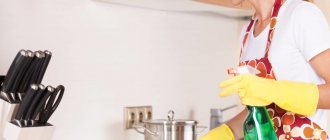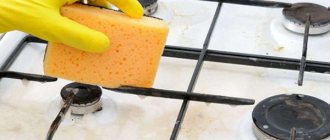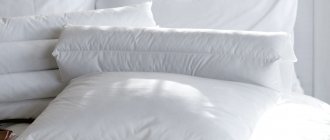Hello, dear readers!
In this article I will tell you how to clean your kitchen until it shines.
Let me start with the fact that not all women enjoy this process. Often, kitchen cleaning is done in a hurry or put off until later. And the kitchen should always shine with cleanliness and order, as it is the face of every home.
Cleanliness in the kitchen is important not only for comfort and a pleasant stay in it, but also for health, since various pathogenic bacteria and microbes breed in dirt. Therefore, I propose to arm yourself with proven methods of adding shine with minimal investment of money and time with maximum results.
It is convenient to divide the kitchen cleaning process into three stages: daily, monthly (depending on the degree of contamination, it can be done more often) and general.
Cooking area
Cleaning the stove
Kitchen cleaning begins with the most contaminated areas - the stove, hood and oven. Remove the burners from the gas burner and wash them with warm water and soap. Electric stove burners are wiped with a damp sponge. Having freed the surface of the slab, a suitable product is applied to it using a sponge.
At the next stage, we move on to the handles - the removable ones can be easily washed with dishwashing detergent. If the elements are not removed, a toothbrush will help clean them - dip it in ammonia diluted in equal parts with water, and carefully clean the handles.
Removing grease and dust from the hood
To wash the hood, use a warm soapy solution. Wipe the outer part of the ventilation with a rag soaked in it, remove the foam with a wet, clean rag, and wipe the surfaces dry. Remove the filters and immerse them in a container with a soap solution. They are put back in after thoroughly washing and drying completely.
Cleaning the oven
Fill a suitable container with warm water and add a mild detergent. The removed oven grates are soaked in the prepared solution to make it easier to remove pieces of food stuck to them.
The oven needs to be washed with special products, or you can prepare an effective composition yourself: mix a quarter glass of salt with ¾ glass of soda, add a quarter glass of water. The paste is applied to the walls of the oven, avoiding holes.
For best results, the product should be left for several hours. You need to remove it with a plastic spatula. After this, all internal surfaces are wiped with a damp cloth. It is easier to remove dirt from an electric stove - you need to turn on the cleaning mode. After the end of the cycle, the remaining stains are washed off with a damp cloth.
Preparatory stage
Kitchen cleaning is carried out in several stages and begins with the preparatory stage. Before starting the process, it is necessary to think through all organizational issues.
Features of the procedure:
- drawing up a cleaning plan, selecting the necessary materials and household chemicals;
- checking the availability of equipment (sponges, cleaning rags, garbage bags);
- to simplify the process and improve the quality of cleaning, it is necessary to clear all surfaces and cabinets of dishes and food;
- remove all food from the kitchen, as the use of household chemicals can be hazardous to health;
- remove curtains, tablecloths and collect towels - place textiles in the washing machine.
Important! For convenience in the cleaning process, you can use special organizers or plastic boxes. The containers can hold food and clean dishes and can be economically placed in any room.
Cleaning the refrigerator
Before cleaning the refrigerator, it is disconnected from the power supply. The main tasks are disinfection of surfaces and elimination of unpleasant odors. You can make an effective remedy yourself: dissolve a couple of teaspoons of soda in ¼ glass of water. A sponge soaked in this mixture is used to treat the shelves and walls of the refrigerator. After this, the surfaces are wiped with a damp cloth and wiped dry.
This home remedy cleans the freezer well: add a teaspoon of vinegar and dishwashing liquid to a glass of water. It is convenient to spray the resulting composition with a spray bottle. If it is not there, the solution can be applied with a sponge. Afterwards, wash the walls with a damp cloth and dry with paper towels.
Where to begin?
Always start cleaning the kitchen from the stove and nearby and nearby objects, because these places are always the dirtiest.
The fat that accumulates on them attracts dust, hair and bacteria. Before scrubbing greasy surfaces, soak all small kitchen utensils in soapy water to make it easier to scrub off grease once you get to them.
When you're done with the stove, continue cleaning the room clockwise, eventually returning to the stove. This way you are guaranteed not to miss a single speck of dust in the kitchen.
To enlarge the picture, click on it
Storage systems and countertops
Tidying up your closets
General cleaning of the kitchen is an excellent reason to sort through supplies and throw away products that have become unusable. To remove dust, stains and crumbs, cabinets and drawers freed from kitchen utensils are treated from the inside with a soap solution.
The outer walls of the set must be cleaned of adhering dirt and grease, and special compounds should be used for wooden furniture. A rag soaked in soapy water can handle light stains. After cleaning the surface, it is necessary to wipe it dry; excess moisture may damage the facades.
Cleaning the countertop
The bath cleaner will not only remove grease splashes and limescale from the table and kitchen apron (if it is made of ceramic tiles), but will also add shine to the surfaces. Cleaning the kitchen certainly includes disinfecting the cutting table. Products containing chlorine are suitable for this. However, they are very aggressive and cannot be used on all surfaces. Table legs are wiped with soapy water.
Day after day
When working in the kitchen, you can use rubber gloves to maintain your manicure.
Now let’s look at how to quickly clean the kitchen after daily cooking, after the whole family has eaten and no one wants to wash the dishes.
The main thing is that you need to adhere to several rules yourself and teach your household to follow them too.
Rule 1 - dishwasher
This rule applies to dishes. Ideal if you have a dishwasher. But even in its absence it is not so difficult to cope with the dishes. The main thing is not to let the dishes dry out with food residues on them.
While cooking, do not throw away empty bowls, containers, knives from food processors, or cutting boards. Rinse it all right away and put it in the dishwasher. In her absence, it is better to immediately wash everything and put it in its place, rather than clutter the sink.
After eating, we also wash the dishes immediately.
Try to involve your household in this too. When the sink is not littered with dirty dishes, it is not difficult at all to wash your plate and cup, even for a child.
Rule 2 - take out the trash
This rule applies to garbage. Try not to accumulate it. Use bags, take them out often, do not allow the formation of an unpleasant odor in the kitchen or the proliferation of microbes.
Rule 3 - routine
This rule applies to little things that need to be done regularly. Once every two to three days it is necessary to change the dish sponge with a new one. We don't need germs, do we?
Change kitchen towels daily and wash them all once a week.
Read also the advice of professionals “How to choose linoleum for the kitchen.”
Rule 4 – looking for helpers
Involve your household in cleaning up the kitchen.
Everyone can be given an assignment. For example, one will monitor the trash and towels, the other will ensure that toys are not scattered in the kitchen.
By the way, children can be taught to put things in order with the help of video games. There are even games that tell you how to clean the kitchen.
Still from the video game for children “Clean the Kitchen”
Rule 5 – final
This rule is the most important. Never go to bed until you have tidied up. It’s nice to start the morning in a tidy, sparkling clean kitchen. Then a great mood for the whole day is guaranteed for the whole family.
Plumbing area
Cleaning the sink
To clean the sink, it is better to use a special product - gel or milk. It is applied to a damp sponge and evenly distributed over the entire surface of the sink. Such products easily remove dirt and are washed off with warm water without leaving streaks.
Mineral deposits on plumbing fixtures are removed by a solution of water and vinegar in equal proportions - a toothbrush will help you reach hard-to-reach areas of the faucet.
Pipe cleaning
A method for removing mild blockages and unpleasant odors from a drain: 250 g of soda poured into the pipe, pour in the same amount of vinegar, and then rinse with plenty of water. You can also use ready-made products - alkaline ones are suitable for the kitchen; they cope better with fat deposits.
Other banks
In addition to the tin ones, you may need to open a glass container. After all, many housewives like to preserve pickles for the winter. Let's look at how to open a jar with different types of lids.
Different lids open in different ways.
You can preserve pickles using roll-on lids at home. But you can purchase a product in a store with a screw cap.
Metal lids are practically no longer used.
To open a purchased can of preserves you need:
- Place the container on a flat surface, then hit the lid with your fist, this will allow the surface to bend. You should not hit too hard, otherwise you may damage your hand;
- lift the screw cap with a knife and break the seal by letting air under it;
- after the clap, you can turn the lid;
- If you don’t have a knife, you can tap the bottom on the bottom, carefully turning the jar over, after which a characteristic pop should appear when you uncork it.
Canned food can be opened with a knife.
For a roll-up lid with home canning, use the following algorithm:
- Using a knife, mark a tick or the letter “L” on the lid, opening a corner so that the ends of the tick rest against the edges;
- Insert a knife and slowly cut along the marked lines;
- Bend its sharp corner and, picking it up with a knife, wrap the cut part around it until the very end;
- Carefully remove the remaining tin to avoid cuts.
Do not try to cut off the lid with a bread knife to avoid metal shavings getting in there.
Advice! If you have a lot of different types of canned food in your home, it would be advisable to buy an electric opener. It simply and easily opens all types of lids - canning, sealing or metal, screw-on. In addition, it is convenient to use for uncorking bottles.
Sources of light and heat
Window cleaning
The glass is wiped with a cloth dampened in warm water, then sprayed with window cleaning spray and wiped dry with a clean cloth. If there is no spray, dilute a spoonful of ammonia or a glass of vinegar in a liter of warm water. Wash the window sill with soapy water.
Battery washing
Cleaning the kitchen cannot be considered complete if you do not wash the batteries; a vacuum cleaner will help remove the dust that has accumulated on them. Place a film under the battery itself and place a tray, this will protect against leaks when washing. Apply detergent to the surface of the battery with a rag or spray bottle, remove dirt between the elements with a brush, and wash off the remaining product with a sponge or damp cloth.
Chandelier cleaning
The lamps are disconnected from power. Products for a chandelier are chosen, paying attention to the materials from which the lighting fixtures are made - for example, aerosols for crystal can damage metal parts. Light stains can be removed with a soap solution.
Kitchen cleaning ends with mopping the floors. There is no point in starting this process earlier - when cleaning other areas, the floor will still get dirty.
How to create comfort - life hack
It’s worth listing some life hacks to feel comfortable in the kitchen. Important attributes of any home that will attract attention and feel cozy:
- Tablecloth and napkins. The table will look neat and “expensive”.
- Set of tableware. It's nice to sit at the table at breakfast or dinner and admire the beautiful plates and cups in the same style. They can create a mood and a.
- Various sets for spices, napkin holders, potholders, towels and cutting boards will add coziness to the kitchen.
- Beautiful curtains and pots of flowers on the windows will help make the kitchen warmer.
The owner spends a lot of time here. If you spend a little time and effort on cleaning, a clean kitchen will gratefully give you a pleasant time with your loved ones over a cup of tea. Cleanliness and comfort will only bring pleasure.
Useful tips
- Do not mix products that contain ammonia with those that contain chlorine. When they combine, they form toxic fumes.
- Chlorine can damage wood and dark surfaces.
- You can lay wax paper on the bottom of the drawers - grease and dust will settle on them. When the paper gets dirty, you just need to replace it with a new one.
How to make cleaning easier? Avoid old stains from appearing as they are more difficult to remove. If you pay attention to certain areas every week, dirt will not accumulate in large volumes, and the need for general cleaning will arise less frequently.
Briefly about what a can opener is
The first tools vaguely resembling modern openers appeared relatively recently - in 1855. Disputes still rage as to who can be called the creator of the can opener. Some give the palm to the Englishman Robert Yates, others to the American Ezra Warner, despite the fact that the latter received a patent for the invention a little later, in 1858.
Early models were not much different from conventional kitchen knives and were inconvenient to use. Even equipping them with a rotating wheel in 1870 did not improve the situation. Only half a century later, a second gear was added to the opener design to secure the device to the can.
Since then, can openers have undergone many metamorphoses, and today you can find hundreds of convenient models on store shelves, from budget to obscenely expensive.
Today on store shelves you can find hundreds of convenient models, from budget to obscenely expensive.
Monthly kitchen cleaning
Once a month, give your refrigerator and freezer a serious cleaning. Put out the food, remove all shelves and drawers, defrost the refrigerator, and wash it.
If you don't use your oven often, you can give it a thorough cleaning once a month. To do this, use oven cleaner.
Once a month, do a complete audit of your cabinets and shelves: empty them of old cans, food, and empty containers. Wipe the shelves with a damp cloth. When removing cabinets, open all doors to ventilate them.
It is necessary to keep the drains clean monthly - this will protect them from clogging. Today there is a very large selection of household chemicals for drains, so it will not be difficult to choose an effective product.
Once a month it is necessary to clean the floor and baseboards. Wet cleaning is done every few days. Monthly cleaning involves cleaning the floor manually using a brush and detergent. Wash not only the floor and baseboards, but also the surfaces under cabinets, radiators, etc.
Daily kitchen cleaning
Many people are accustomed to setting aside one day, for example, Saturday, and devoting it entirely to cleaning the kitchen. But if you keep it clean every day, it will be easier for you to do a general kitchen cleaning. Daily maintenance of cleanliness includes cleaning all work surfaces - just walk over them with a cloth and detergent.
After preparing food, we are left with a lot of dirty dishes. A smart way is to fill the sink with hot water and detergent, and then, as dirty dishes appear, put them there. While you are cooking, the dishes will get wet, and all you have to do is rinse them.
Another daily task that will help you save time is to audit your refrigerator: remove all spoiled food and leftover food. If you clean the refrigerator every day for 2-3 minutes, it will be much easier for you to wash it during spring cleaning in the kitchen.
One of the most difficult tasks is cleaning the stove from grease and burnt-on food debris. To make your task easier, wipe the stove daily, after each cooking: both the work area and the side walls. If you baked something in the oven, wipe it down both inside and outside.











